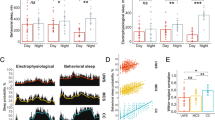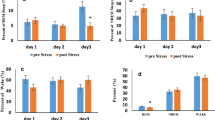Abstract
Rationale
New sleep disturbance model in rats is useful for estimating the characteristics of some hypnotics.
Objectives
The present study was undertaken to investigate the utility of a sleep disturbance model by placing rats on a grid suspended over water using three kinds of hypnotics, that is, short-acting benzodiazepine (triazolam), intermediate-acting benzodiazepine (flunitrazepam) and long-acting barbiturate (phenobarbital).
Methods
Electrodes for measurement of EEG and EMG were implanted into the frontal cortex and the dorsal neck muscle of rats. EEG and EMG were recorded with an electroencephalogram. SleepSign ver.2.0 was used for EEG and EMG analysis. Total times of wakefulness, non-REM and REM sleep were measured from 0900 to 1500 hours.
Results
In rats placed on the grid suspended over water up to 1 cm under the grid surface, not only triazolam but also flunitrazepam and phenobarbital caused a shortening of sleep latency. Both flunitrazepam and phenobarbital were effective in increasing of total non-REM sleep time in rats placed on sawdust or the grid, and the effects of both drugs in rats placed on the grid were larger than those in rats placed on sawdust. Measurement of the hourly non-REM sleep time was useful for investigating the peak time and duration of effect of the three hypnotics. Phenobarbital showed a decrease in total REM sleep time in rats placed on the grid, although both triazolam and flunitrazepam were without effect.
Conclusions
The present insomnia model can be used as a sleep disturbance model for testing not only the sleep-inducing effects but also the sleep-maintaining effects including non-REM sleep and REM sleep of hypnotics.


Similar content being viewed by others
References
Bertorelli R, Ferri N, Adami M, Ongini E (1996) Effects of four antiepileptic drugs on sleep and waking in the rat under both light and dark phases. Pharmacol Biochem Behav 53:559–565
Cerone G, Cirignotta F, Coccagna G, Milone F.F, Lion P, Lorizio A, Lugaresi E, Mantovani M, Muratorio A, Murri L, Mutani R, Riccio A (1974) All-night polygraphic recordings on the hypnotic effects of a new benzodiazepine: flunitrazepam (Ro 5-4200, Rohypnol®). Eur Neurol 11:172–179
Depoortere H, Decobert M, Granger P, Riou-Merle F (1986) Hypnotics: clinical value of pharmaco-EEG methods. Neuropsychobiology 16:157–162
Freeman HL (1996) Is there a need for a pure hypnotic? Approaches to the co-diagnosis of insomnia and anxiety. J Drug Dev Clin Pract 7:289–302
Halperin JM, Miller D, Iorio LC (1981) Sleep-inducing effects of three hypnotics in a new model of insomnia in rats. Pharmacol Biochem Behav 14:811–814
Hilbert JM, Battista D (1991) Quazepam and flurazepam: differential pharmacokinetic and pharmacodynamic characteristics. J Clin Psychiatry 52:21–26
Huang Z-L, Qu W-M, Li W-D, Mochizuki T, Eguchi N, Watanabe T, Urade Y, Hayaishi O (2001) Arousal effect of orexin A depends on activation of the histaminergic system. Proc Natl Acad Sci 98:9965–9970
Karacan I, Orr W, Roth T, Kramer M, Thornby J, Bingham S, Kay D (1981) Dose-related effects of phenobarbitone on human sleep-waking patterns. Br J Clin Pharmacol 12:303–313
Kuhn FJ (1986) Effects of brotizolam on the sleep-waking cycle of the cat. Arzneimittelforschung 36:522–527
Lancel M (1999) Role of GABAA receptors in the regulation of sleep: initial sleep responses to peripherally administered modulators and agonists. Sleep 22:33–42
Paxinos G, Watson C (1986) The rat brain in stereotaxic coordinates, 2nd edn. Academic Press, San Diego
Saitou K, Kaneko Y, Sugimoto Y, Chen Z, Kamei C (1999) Slow wave sleep-inducing effects of first generation H1-antagonists. Biol Pharmacol Bull 22:1079–1082
Shinomiya K, Shigemoto Y, Okuma C, Mitsunobu M, Kamei C (2003) Effects of short-acting hypnotics on sleep latency in rats placed on grid suspended over water. Eur J Pharmacol 460:139–144
Viukari M, Jaatinen P, Kylmämaa T (1983) Flunitrazepam and nitrazepam as hypnotics in psychogeriatric inpatients. Clin Ther 5:662–670
Vogel GW, Barker K, Gibbons P, Thurmond A (1976) A comparison of the effects of flurazepam 30 mg and triazolam 0.5 mg on the sleep of insomniacs. Psychopharmacology 47:81–86
Wheatley D (1992) Prescribing short-acting hypnosedatives: current recommendations from a safety perspective. Drug Safety 7:106–115
Yoshimoto M, Higuchi H, Kamata M, Yoshida K, Shimizu T, Hishikawa Y (1999) The effects of benzodiazepine (triazolam), cyclopyrrolone (zopiclone) and imidazopyridine (zolpidem) hypnotics on the frequency of hippocampal theta activity and sleep structure in rats. Eur Neuropsychopharmacol 9:29–35
Author information
Authors and Affiliations
Corresponding author
Rights and permissions
About this article
Cite this article
Shinomiya, K., Shigemoto, Y., Omichi, J. et al. Effects of three hypnotics on the sleep-wakefulness cycle in sleep-disturbed rats. Psychopharmacology 173, 203–209 (2004). https://doi.org/10.1007/s00213-003-1727-0
Received:
Accepted:
Published:
Issue Date:
DOI: https://doi.org/10.1007/s00213-003-1727-0




